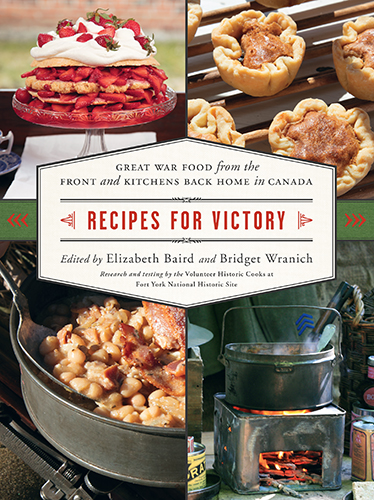Recipes for Victory combines history and cooking as it presents domestic and military recipes (and their modern-day equivalents) used during the Great War — in the trenches, behind the lines, an
Recipes for Victory combines history and cooking as it presents domestic and military recipes (and their modern-day equivalents) used during the Great War — in the trenches, behind the lines, and on the home front.
Profusely illustrated with historical drawings and photographs, the text explores the role of the army cook, what soldiers ate in and behind the trenches, the war time efforts on the home front, the role of alcohol, the importance of food packages from home, and the problems of surplus. The text also explores the Children's Potato War Plot Fund, the Vacant Land Cultivation act, and the importance of home gardens. Three elucidating essays by Wayne Reeves, Chief Curator, Museum and Heritage Services, City of Toronto; Kevin Hebib, Program Development Officer, Fort York National Historic Site, and David Webb, Ontario Region Military Curator (ret), Parks Canada, provide fascinating details about the role of food in war.
Elizabeth Baird has been shaping Canada's culinary history for many decades. She has written many, many cookbooks, had a long-running weekly column in the Toronto Star, and was the Food Editor of Canadian Living for many years. Currently she writes for the Toronto Sun, in addition to being a volunteer historic cook at Fort York.
Bridget Wranich is a culinary historian and expert on late 18th and 19th century cooking in Canada.
The Volunteer Historic Cooks at Fort York are dedicated food enthusiasts who meet regularly to research, test, and prepare recipes for cooking classes, demonstrations, ceremonies and special events.
View Biographical note
"This is 'Great War' food from the front and the kitchens back home in Canada; it grew out of a Fort York-Culinary Historians of Canada symposium in 2014 which was called for the centennial of the start of the War. This cookbook has been published (with much added research and preps) in time to celebrate the 1918 conclusion of that War to End All Wars. The teams deal with three distinct kitchens: the war front, the gifts from the home front in the trenches, and the kitchens at home. They cover the role of the army cook, alcohol, food packs from home, problems of surplus, home gardens, and some special topics such as the Children's Potato War Plot Fund. Of course, there are recipes: each has an original taken from a notebook and a modern equivalent. Usually there are illustrations of drawings and photos. A dynamic work, well-written and well-worth reading over the holidays. Bravo!"
— Dean Tudor
"This book is a priceless resource for anyone wishing to recreate WWI-era cookery; I know of no other that offers such a wide range of recipes faithfully redeveloped for today's cooks of all skill levels. Its subtitle is clever, because ultimately Recipes for Victory is not just about food of the Great War, but also great war food."
— Culinary Historians of Canada
View Review text
CONTENTS
Preface
Delectable Weapons: Food, Drink and Canadians during the First World War
Wayne Reeves, Chief Curator, Museums and Heritage Services, City of Toronto
Food Rations at The Front: More Than Bully Beef and Biscuits
Kevin Hebib, Program Development Officer, Fort York National Historic Site
The Military Cooking Notebooks of William J. Johnston
David Webb, Ontario Region Military Curator (retired), Parks Canada
At the War Front
From the Military Cooking Notebooks of William J. Johnston
From the Canadian Army?s Manual of Military Cooking, 1916
On the Home Front
Gifts Sent Overseas
Saving Food for the War Effort
From Kitchens at Home
Soups and Snacks
Mains
Vegetables, Salads and Preserves
Desserts
Beverages and Breakfasts
General Bibliography
Culinary Bibliography
Acknowledgments
Image Credits
Recipe Index
About the Contributors
View Table of contents

